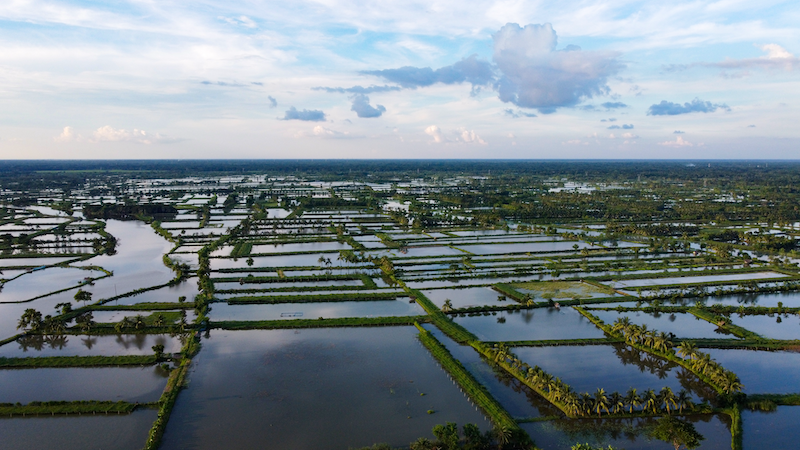
Laura Zseleczky
In 2021, the Feed the Future Innovation Lab for Fish continued progress toward its goal of reducing poverty and improving nutrition, food security, and livelihoods by supporting the sustainable development of aquaculture and fisheries systems.
Last year was the first full year for the Fish Innovation Lab’s 13 competitively awarded research activities across five countries in Africa and Asia. The lab also commissioned six new activities to address key areas of need, complement ongoing work, and foster strategic partnerships, including in two new countries. While the COVID-19 pandemic continued to present challenges for the research teams, especially in terms of travel, they adapted and pivoted, drawing on strong host-country partnerships to conduct on-the-ground research and utilizing virtual technologies to connect teams and stakeholders across the globe.
“Our teams have done a tremendous job finding creative solutions to ensure the Fish Innovation Lab’s work moves forward,” said Mark Lawrence, director of the Fish Innovation Lab and professor of veterinary medicine at Mississippi State University. “From launching stakeholder trainings to completing surveys and data collection, this was a year of major strides toward helping people who depend on fish as an essential source of nutrients and income.”
To achieve its goals, the Fish Innovation Lab focuses on three program areas: advancing productivity, reducing and mitigating risks, and improving human outcomes.
In 2021, accomplishments in advancing productivity in aquaculture included improving the efficiency of aquaculture production, feed production, and fish processing in Nigeria by applying the principles of “Lean Management Systems,” first developed by Toyota Manufacturing to improve operational efficiency in the automotive sector. Another team in Nigeria established experimental plots to pilot integrated rice-fish farming, which will help producers diversify their operations and contribute to improved food security and access to nutritious options for consumers. In Bangladesh, researchers developed a cryogenic sperm bank for four species of carp and mapped genetic characteristics that will help government and private hatcheries improve breeding and production programs for aquaculture.
Last year’s activities also focused on productivity in fisheries systems, including launching community-led monitoring activities to track fish catch and other key indicators for sustainable fisheries management in coastal Kenya and developing a searchable photo identification catalog of freshwater fishes harvested in Cambodia.
“More than 2.6 billion people depend on some form of fish for over 20% of their total animal protein—and as the global population increases, so too will demand for fish. The Fish Innovation Lab’s work to enhance the productivity of aquaculture and fisheries systems will contribute significantly to ensuring more people can access fish as part of their diet and drive income growth among people employed in these sectors,” said Lawrence.
Research teams working with the Fish Innovation Lab also addressed risk reduction and mitigation. A team in Nigeria conducted epidemiologic surveys of catfish and tilapia and analyzed biological samples from private fish farms. The results will help the team identify the major disease challenges for Nigerian aquaculture producers and develop better management practices to reduce the risk of disease outbreaks. In Bangladesh, Fish Innovation Lab researchers completed a survey examining the prevalence of foodborne pathogens in the products of fish processors in Dhaka City. The team will use this data along with results from a study of behavioral practices of different actors along the fish value chain to identify the most effective points of intervention to reduce microbial contamination in informal fish markets of Bangladesh.
Improving human outcomes, including nutrition and income from aquaculture- and fisheries-based livelihoods, was also a key focus for the Fish Innovation Lab in 2021. According to Lawrence, “Well-managed aquaculture and fisheries systems have the potential to improve nutrition and income, but more evidence is needed on how these systems can positively impact the lives and livelihoods of vulnerable groups. The Fish Innovation Lab made great progress in providing some of that evidence over the last year.”
In Bangladesh, researchers conducted a census of households, farmers, fish traders, and input suppliers to better understand the aquaculture value chain, and they developed a series of short videos to share innovative aquaculture approaches with stakeholders. A team in Nigeria launched a nutrition and food safety training program for fish processors, which has already helped participants improve their processing operations and expand their customer base. Meanwhile, researchers in Kenya launched a social marketing campaign targeting caregivers and fishers with information about child nutrition, diet diversity, and sustainable fishing practices. In Zambia, Fish Innovation Lab researchers surveyed fishers, processors, and traders near Lake Kariba to how understand how equitable access to fish and nutrition is in the region. These findings will inform the team’s efforts to address malnutrition and empower local communities, including through the production of nutritious dried fish powder-based products.
In addition to the three program areas, four cross-cutting themes are incorporated into all Fish Innovation Lab activities and guide the lab’s work overall: mainstreaming gender equity and youth inclusion, advancing human and institutional capacity development, strengthening resilience, and advancing nutrition.
“I’m very pleased with the progress our teams made in 2021, and I look forward to the year ahead,” said Lawrence. “In 2022, we expect that many of the teams will be translating the findings of their research into recommendations for partners and stakeholders in the countries where we work. We will also explore opportunities for scaling and adoption of some of the innovative technologies and approaches that our teams are testing to extend the reach of the benefits and long-term sustainability of these activities.”
To learn more about the Fish Innovation Lab’s activities in 2021, read the annual report.
Published January 31, 2022
